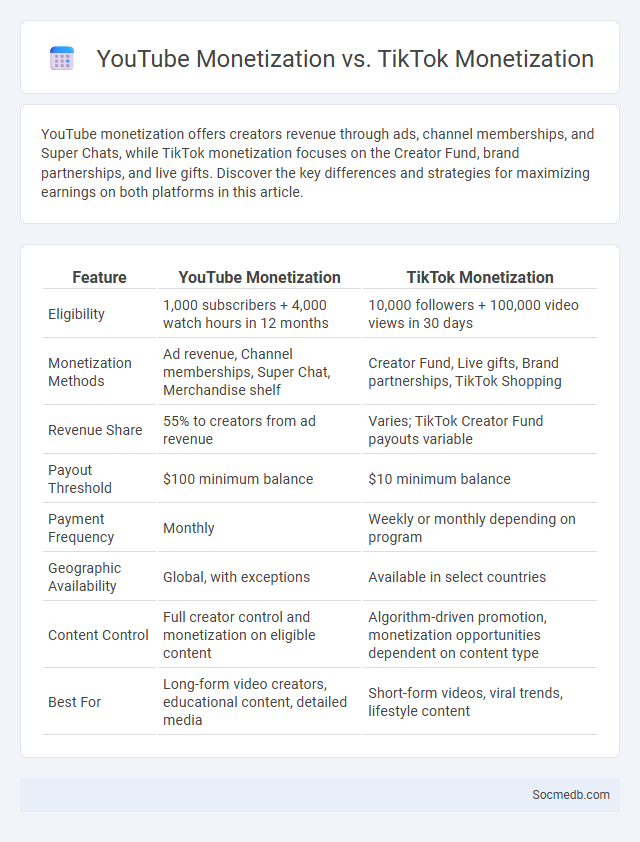
Photo illustration: YouTube Monetization vs TikTok Monetization
YouTube monetization offers creators revenue through ads, channel memberships, and Super Chats, while TikTok monetization focuses on the Creator Fund, brand partnerships, and live gifts. Discover the key differences and strategies for maximizing earnings on both platforms in this article.
Table of Comparison
| Feature | YouTube Monetization | TikTok Monetization |
|---|---|---|
| Eligibility | 1,000 subscribers + 4,000 watch hours in 12 months | 10,000 followers + 100,000 video views in 30 days |
| Monetization Methods | Ad revenue, Channel memberships, Super Chat, Merchandise shelf | Creator Fund, Live gifts, Brand partnerships, TikTok Shopping |
| Revenue Share | 55% to creators from ad revenue | Varies; TikTok Creator Fund payouts variable |
| Payout Threshold | $100 minimum balance | $10 minimum balance |
| Payment Frequency | Monthly | Weekly or monthly depending on program |
| Geographic Availability | Global, with exceptions | Available in select countries |
| Content Control | Full creator control and monetization on eligible content | Algorithm-driven promotion, monetization opportunities dependent on content type |
| Best For | Long-form video creators, educational content, detailed media | Short-form videos, viral trends, lifestyle content |
Introduction to Social Media Monetization
Social media monetization involves transforming your online presence into a revenue-generating asset by leveraging platforms like Instagram, YouTube, and TikTok. Effective strategies include sponsored content, affiliate marketing, and selling digital products to reach targeted audiences. Understanding platform algorithms and audience engagement metrics is crucial to maximizing your social media income potential.
Overview of YouTube Monetization Methods
YouTube monetization methods primarily include AdSense revenue, channel memberships, Super Chat, and merchandise shelf integration. Content creators earn money through ads displayed on their videos, direct fan support via memberships and Super Chat, and by promoting their products. Diversifying these income streams maximizes channel profitability and long-term sustainability.
Overview of TikTok Monetization Methods
TikTok offers multiple monetization methods, including Creator Fund payments, brand partnerships, and live gifting features that enable content creators to earn revenue directly from their audience. You can also leverage in-app shopping tools and sponsored content opportunities to maximize your earnings on the platform. Understanding TikTok's algorithm and engagement metrics is crucial for optimizing your monetization potential effectively.
Understanding Ad Revenue Streams
Ad revenue streams on social media platforms primarily derive from targeted advertising, where user data enables precise audience segmentation to maximize campaign effectiveness. Platforms like Facebook, Instagram, and YouTube generate substantial income through pay-per-click (PPC), cost-per-impression (CPM), and influencer partnerships, leveraging high user engagement metrics. Understanding the interplay of algorithms, ad formats, and user behavior is critical for optimizing revenue generation in the competitive digital advertising ecosystem.
Eligibility Requirements for Monetization
To qualify for monetization on social media platforms like YouTube, creators must typically meet a minimum subscriber count--often 1,000 subscribers--and achieve a set number of watch hours, commonly 4,000 hours in the past 12 months. Compliance with the platform's community guidelines and copyright policies is essential to maintain monetization eligibility. Verification of an active linked AdSense account is required to receive revenue through ads, memberships, or super chats.
Revenue Sharing Models: YouTube vs TikTok
YouTube offers a revenue sharing model where creators receive 55% of ad revenue generated from their videos, incentivizing high-quality content and longer watch times. TikTok, on the other hand, primarily uses a creator fund system with variable payouts based on video views and engagement, often resulting in lower earnings per view compared to YouTube. Your choice between these platforms should consider how each revenue model aligns with your content strategy and audience reach goals.
Factors Affecting Earnings on Each Platform
Earnings on social media platforms are primarily influenced by audience size, engagement rate, and content niche. Platforms like Instagram and YouTube reward creators with high interaction metrics and targeted demographics through advertising revenue and brand collaborations. Furthermore, platform-specific algorithms and monetization policies significantly impact a creator's ability to generate income.
Best Practices for Maximizing Ad Revenue
Maximizing ad revenue on social media requires targeting precise audience segments using advanced analytics tools to increase engagement and conversion rates. Implementing A/B testing for ad creatives and placements helps identify the most effective strategies for higher click-through rates and ROI. Consistently updating content to align with platform algorithms and user trends ensures sustained visibility and monetization growth.
Creator Success Stories: YouTube vs TikTok
YouTube has propelled creators like MrBeast and Emma Chamberlain to global fame through long-form, monetizable content and a robust ad revenue system, fostering sustainable income streams. TikTok's algorithm-driven discovery favors viral short videos, enabling creators such as Charli D'Amelio and Khaby Lame to rapidly amass millions of followers and brand partnerships. Both platforms excel in creator success but differ in content style, monetization models, and audience engagement dynamics.
Conclusion: Which Platform Pays More?
TikTok creators often earn higher revenue through its Creator Fund and brand partnerships, particularly for viral short-form content. YouTube offers substantial income via ad revenue sharing, especially with longer videos and consistent channel monetization. Instagram monetizes primarily through sponsored posts and affiliate marketing, yielding variable earnings based on follower engagement and niche.
 socmedb.com
socmedb.com